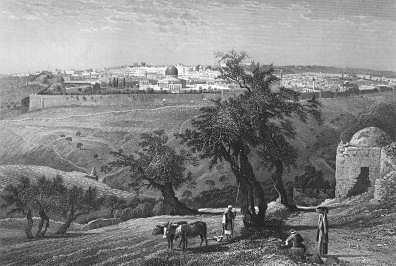
Jerusalem from the Mount of Olives
It is easy to dismiss past travel writing about the “Orient†as mere “Orientalism,” the kind that Edward Said disparaged as a style for dominating the supposed “Oriental†other. But viewing such texts through a politicized post-colonial lens thus becomes a kind of scorched-earth form of literary criticism. True enough, there are many narratives, especially by Christian writers, that approach the physical ‘Holy Land’ with a schizophrenic ax to grind: an over-appreciation of the biblical character of the land coupled to an under-valuing of the people who lived in the land at the time. But occasionally there are texts that dig beneath the surface if the reader has the patience to read beyond the surface rhetoric. One of these is a delightful first-person narrative by Philip J. Baldensperger, published in 1913 about experiences in Palestine during the last half of the 19th century.
The title of Baldensperger’s text, The Immovable East, would seem to be ripe fodder for politically correct critique. Yet the narrative is at times moving and intensely personal. Although born of missionary parents in Jerusalem in 1856, Philip writes about his life experience in admiration of the men and women he met and knew. There are no ‘heathen’ to be converted in the text, but a number of splendid examples of humanity. Young Philip grew up counting what we would assume were others as friends. After serving for five years in the Franco-Prussian War, he returned to Palestine in 1880 and joined his brothers as a businessman, specifically beekeeping on a commercial level. Then in 1893 he left and moved with his American wife to Nice.
In the introduction to Baldensperger’s book, Frederic Lees makes an interesting point about the quality of travel books on the “East.†As noted below, there is an awareness of a tendency by academics of the time to view the area through ‘Occidental’ eyes. The significant observation is that the self-description of real Orientals or exposure of a Westerner through a “long sojourn†(and this at a time before modern ethnography had begun) can make for a far more informative and trustworthy narrative. Here is Lees’ explanation:
“Books descriptive of the East may be roughly divided into three classes. First, there are the volumes of ‘Impressions’ of literary men who set themselves the difficult task, after a more or less lengthy stay in the Orient, of faithfully representing Oriental scenes, manners and customs. These are interesting principally on account of their authors – they are vivid, personal interpretations of Eastern life by men of undeniable power of observation and descriptive skill. Intended more for the general reader than the student, these impressionistic studies serve the useful purpose of revealing the brilliant and ever-fascinating surface of the East. Rarely do they take us to its depths. To gain a deeper knowledge of Orientalism, we must go to a second category of books, – those written by professional Orientalists, whose special linguistic studies and extensive travels entitle them to be ranked as authorities. But here again these writers do not tell us all. They too often view the Orient through Occidental eyes, and in certain vital respects fail to paint the picture in its true colors. Only by Orientals – or by those whose long sojourn in the East has formed their minds after the Oriental pattern – can the Orient be adequately described†(Lees in Baldensperger, The Immovable East, London, Sir Isaac Pitman and Sons, 1913, pp vii).
To be continued in a future post.